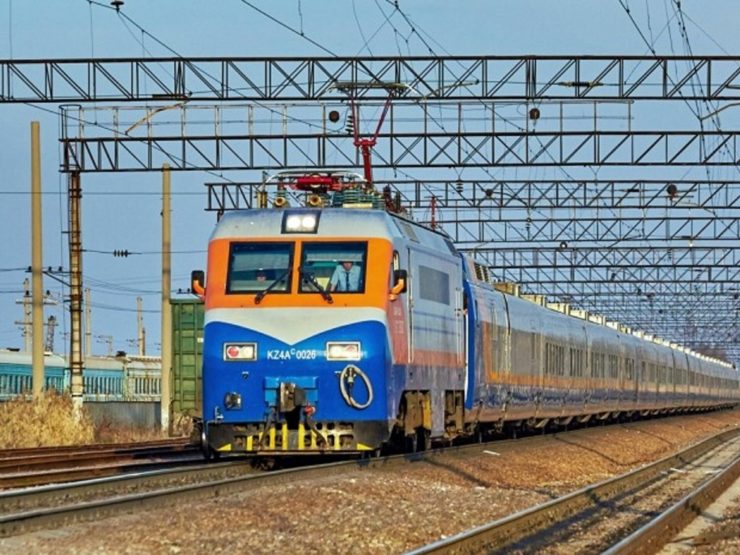
According to the Statistical Service of Kazakhstan, the total volume of goods transported by rail between Kazakhstan and China reached 23 million tons as early as 2022 and grew by a record 22 percent last year.
In view of this high volume of freight traffic and the clear upward trend, the Kazakh authorities are having to invest heavily in the development of new railroads in order to serve the growing freight volumes and enable the rapid and efficient delivery of goods through the country. This task is especially urgent in view of the Asia-Europe corridor projects initiated in 2022-2023 in other countries, which threaten to reduce the importance of Kazakhstan in terms of cross-continental transportation. These other projects include the Central, Western and Eastern corridors in Mongolia, the China-Kyrgyzstan-Uzbekistan highway in Kyrgyzstan, and the China-Tajikistan-Uzbekistan-Turkmenistan multimodal corridor project in Tajikistan, all of which are capable of competing with Kazakh routes of varying degrees of seriousness. In addition to them, as the Kazakh authorities are well aware, Russian President Vladimir Putin has instructed his government to study the prospects of creating a railroad corridor between Russia and China, passing through Mongolia.
That is the background to the recent announcement by the Kazakh government that it plans to build a new railroad line bypassing Almaty, the country’s largest city and its former capital.
The new Zhetygen-Kazybek-Bek railroad will bypass the Almaty conurbation, passing between the northern outskirts of Almaty and the Kapshagai reservoir. It will be part of a major continental railway mainline connecting the border crossings on the Chinese-Kazakhstan border (such as the existing and rapidly developing Altynkol-Khorgos, and the Bakhty-Chuguchak and Kalzhat crossings, which are still under construction, albeit at different stages of development) with Transcaucasia and Europe.
The construction of the highway was announced by the Kazakh government back in 2022, and work began on the project on November 14, 2023. As announced, in terms of both the funding and the technology used, this will be a primarily Kazakh project: 85% of the work will be performed by Kazakh companies and most of the financing will come from the national budget. The length of the new railway will be 130 kilometers. The cost of the work is estimated at $212 million (96 billion tenge).
The old main line which serves the existing border crossings is unable to cope with the growing volumes of freight, and is also inconveniently located for the East-West route: it runs from Kazakhstan’s border with China to Zhetygen where it makes a sharp turn southwards, passing through the center of Almaty before again turning westwards and then passing through the city. The second branch goes due north from Zhetygen, and thus the only way it could be useful for the purposes of Eurasian transit would be as part of a China-Kazakhstan-Russia-Europe route. However, it would not serve as an effective alternative to the route from the other railroad crossing on the Kazakhstan-PRC border, Dostyk-Alashankou, which is further north and therefore closer to the main railroads of both the PRC and the Russian Federation. The creation of a new Zhetygen-Kazybek-Bek railroad would cut the journey time through the Almaty region by an impressive 24-48 hours.
At the beginning of 2024 new details of this project were announced. Under a Presidential decree dated January 9, 2024, the settlement of Zhetygen is granted the status of “city of regional importance” and renamed Alatau (after the “piebald” mountain in the region), in recognition of its future role, upon completion of the works on the railroad, as the main transport hub in the whole of Almaty region. This decision is clearly intended to promote the development of the infrastructure supporting the new main line – after all, a significant share of enterprises and facilities servicing the railroad remain in Almaty, on the section that will no longer form part of the Eurasian transit route. Shortly after the issue of the above decree, plans for the development of the new city and its inclusion in a new Free Economic Zone were published.
Thus, the Zhetygen-Kazybek-Bek railroad, along with other railroad projects currently being implemented by Kazakhstan (the Darbaza-Maktaaral, Bakhty-Ayagoz and Dostyk-Moyinty lines) and a promising project to create new railroad border crossings with China (the Bakhty-Chuguchak and Kalzhat crossings) are designed to significantly increase the competitiveness of the Eurasian transit routes passing through Kazakhstan. And if the Dostyk-Moyinty and Bakhty-Ayagoz lines are designed to optimize the existing China-Kazakhstan-Russia-Europe route then the Darbaza-Maktaaral railroad and the Zhetygen (Alatau)–Kazybek-Bek railroad discussed in this article are designed to serve completely new routes, such as a North-South route (Russia-Kazakhstan-Uzbekistan) and new variations of the existing West-East routes – China-Kazakhstan-Turkmenistan, China-Kazakhstan-Uzbekistan-Turkmenistan and China-Kazakhstan-Azerbaijan.
Boris Kushkhov, the Department for Korea and Mongolia at the Institute of Oriental Studies of the Russian Academy of Sciences, exclusively for the online magazine “New Eastern Outlook”
